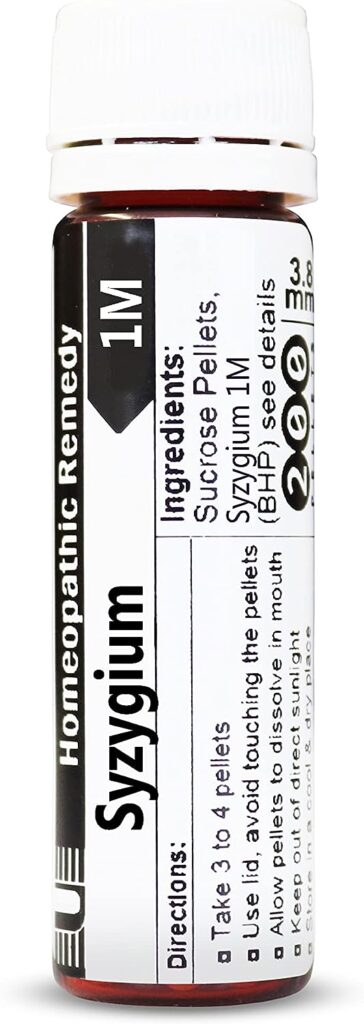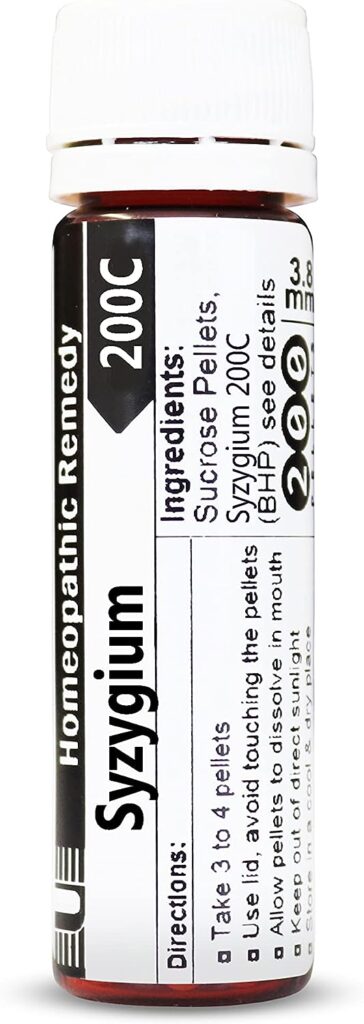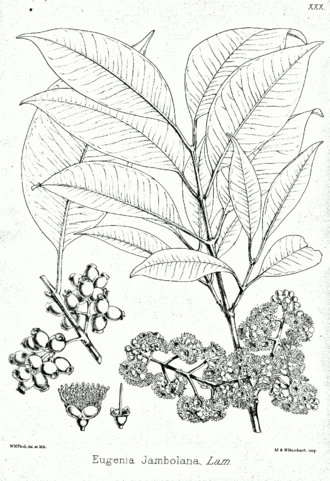Syzygium cumini, commonly known as Malabar plum, Java plum, black plum, jamun, jaman, jambul, or jambolan, represents an evergreen tropical tree belonging to the Myrtaceae family. It boasts a rich history of utility for its fruit, timber, and ornamental features. This tree is indigenous to the Indian subcontinent and Southeast Asia, encompassing regions such as Myanmar, Sri Lanka, Bangladesh, and the Andaman Islands. Remarkably, Syzygium cumini can achieve towering heights of up to 30 meters and exhibit a lifespan exceeding 100 years. Despite its virtues, this fast-growing plant has gained notoriety as an invasive species in numerous parts of the world.
The geographical reach of Syzygium cumini extends beyond its native territories, as it has been introduced to various regions, including Pacific and Indian Ocean islands, Australia, Hong Kong, and Singapore. This tree’s adaptability has enabled it to flourish in diverse climatic conditions. Additionally, the delectable fruits of Syzygium cumini serve as a crucial food source for numerous native avian species and small mammals, such as jackals, civets, and fruit bats.

Historical Significance
Syzygium cumini holds a significant place in both Indigenous Australian culture and traditional medicine. Indigenous Australians referred to the plant as “durobbi,” and the fruit, resembling a damson in appearance, bears a somewhat astringent and acidulous yet sweetish flavor. It has been a favored food source among the native populace. Notably, it also serves as sustenance for birds and is a preferred dietary item for flying foxes.
The leaves and fruits of Syzygium jambolanum, a botanical synonym of Syzygium cumini, have been employed in traditional medicine by indigenous communities to address infectious diseases, diabetes, and gastrointestinal discomfort. This plant’s bactericidal properties have been confirmed through in vitro studies. As a testament to its therapeutic potential, it has been evaluated for its prophylactic effects in murine models of polymicrobial infections induced by cecal ligation and puncture (CLP). This underscores the intricate relationship between traditional medicinal knowledge and modern scientific investigation.
Treatment for Diabetes:
Derived from the seeds of this fruit, Syzygium jambolanum has been studied for its antidiabetic properties. Homeopathic practitioners have explored its use in managing diabetes due to its reputed ability to regulate blood sugar levels. While more research is needed to comprehensively establish its efficacy and mechanisms of action, Syzygium jambolanum remains a subject of interest in the context of alternative and complementary approaches to diabetes management within the realm of homeopathy.

Materials and Methods of a Study:
Diabetes was induced in Wistar strain rats through the administration of streptozotocin at a dose of 4 mg/100 gm body weight. A series of biochemical assays were performed to assess various parameters, including the activity of carbohydrate metabolic enzymes in hepatic tissue, glycogen content in hepatic and muscular tissues, serum lipid profile levels, and the activities of glutamate oxaloacetate transaminase (GOT) and glutamate pyruvate transaminase (GPT) in serum.
The administration of S. jambolanum mother tincture produced significant reductions in fasting blood glucose levels and improvements in the activities of key carbohydrate metabolic enzymes in hepatic tissue, including hexokinase, glucose-6-phosphate dehydrogenase, and glucose-6-phosphatase. Furthermore, serum lipid profile biomarkers, including triglyceride (TG), total cholesterol (TC), low-density lipoprotein cholesterol (LDLc), very low-density lipoprotein cholesterol (VLDLc), and high-density lipoprotein cholesterol (HDLc) levels, exhibited significant amelioration in the diabetic rats treated with S. jambolanum. Additionally, the homeopathic remedy demonstrated a protective effect against diabetes-induced hepatic injury, as evidenced by the restoration of GOT and GPT activities in the serum of drug-treated diabetic animals.

Historical Significance (Syzygium cumini):
Syzygium cumini enjoys recognition not only in India, where it is known as Naval pazham, but also in English-speaking regions as jambolan, sweet olive, or java plum. This member of the Myrtaceae family has historically been harnessed to combat bacterial, fungal, and viral infections. In addition to its anti-microbial attributes, it has found application in addressing genitourinary ulcers caused by Candida albicans, as well as various common maladies including colds, coughs, fevers, and skin afflictions like rashes. Furthermore, it has been integrated into traditional medicinal practices to manage digestive disorders, with historical remedies including formulations of Syzygium cumini with honey or milk to treat diabetes and gastrointestinal ailments. The consumption of fresh fruit has also been a longstanding practice for alleviating stomachaches.
Syzygium cumini thus stands as a multifaceted botanical entity, celebrated for its ecological significance, historical roles in traditional medicine, and modern scientific investigations into its therapeutic potential.
Not a Highly Manufactured Remedy:
Syzygium jambolanum is produced by various homeopathic manufacturers, such as Urenus, but not the most popular manufacturer Boiron. The availability of homeopathic remedies from different manufacturers offers patients and practitioners a choice in terms of the source and formulation of these remedies. The choice of a particular manufacturer might be influenced by various factors, such as historical use, regional preferences, or specific production methods. Speculating on why Urenus, in particular, produces this remedy, one could consider factors like the company’s expertise in sourcing the raw materials needed for this remedy, the manufacturing processes they employ, or their commitment to quality control. Ultimately, the decision of which manufacturer to choose may vary among practitioners and patients, with each having their own reasons for selecting a particular brand. Boiron did not offer commentary on why they don’t produce this particular remedy.
